Ours is a holistic approach that does not hinder the physiological processes of the body. It's an approach that encourages the restoration of balance, by combatting the causes of symptoms as efficiently as possible and ensuring fast relief.
Symptoms and relief
SELECT YOUR NEED

Mouth
Herpes-related disorders and symptoms
COLD SORES ARE CAUSED BY THE HERPES SIMPLEX VIRUS TYPE 1 (HSV-1) OR MORE RARELY BY THE HERPES SIMPLEX VIRUS TYPE 2 (HSV-2), AND AFFECT 3.7 BILLION PEOPLE WORLDWIDE
Monti M., «Herpes labiale, colpite al mondo 3,7 miliardi di persone» Humanitas Salute, 2 November 2015

IN ITALY, 93% OF THE POPULATION HAS COME INTO CONTACT WITH HSV-1 AND ARE CARRIERS OF THE VIRUS IN ITS LATENT FORM
Marchi S. et al., «Epidemiology of herpes simplex virus type 1 and 2 in Italy: a seroprevalence
study from 2000 to 2014”.J. Prev. Med. Hyg. 2017; (58), p. E27-E33
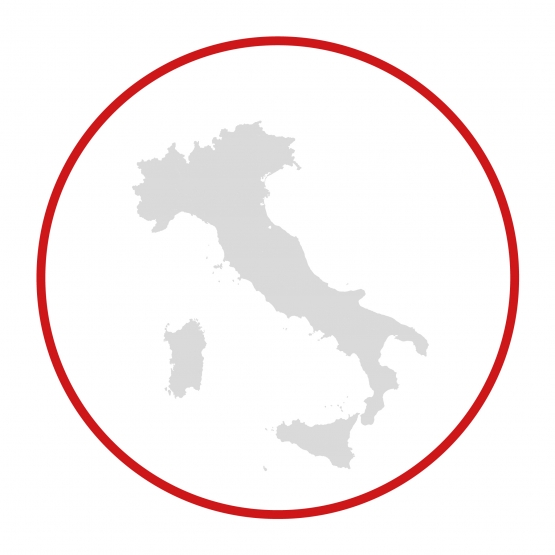
AFTER THE FIRST INFECTION, HSV REMAINS IN THE BODY PERMANENTLY, CYCLING FROM A LATENT FORM TO AN ACUTE INFECTIOUS PHASE
- Primary infection: first contact generally occurs during childhood and often manifests as aphthous gingivostomatitis.
- Latent phase: after healing, the virus ascends through the nerve fibers to the trigeminal nerve ganglion where it remains in a quiescent form.
- Recurrent herpes: following exposure to risk factors, the virus goes backward through the nerve fibers and re-emerges on the surface, where it replicates and gives rise to the typical lesions, located mainly on the lips.
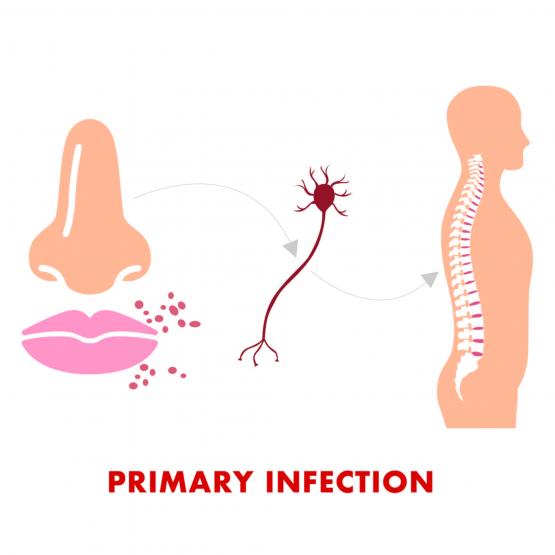
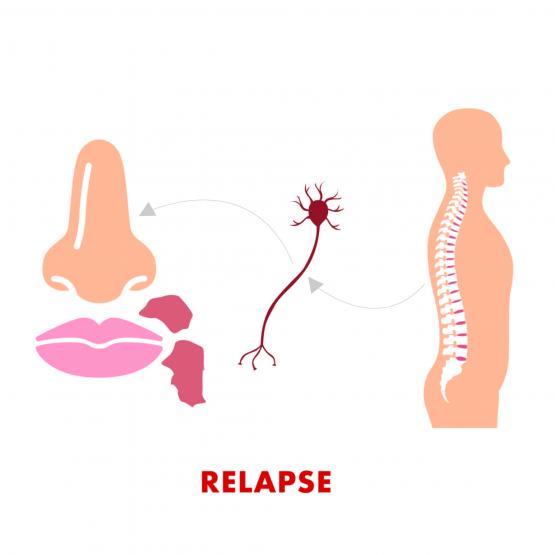
THE WEAKENING OF IMMUNE DEFENSES IS ALWAYS PRESENT DURING SKIN MANIFESTATIONS
Intrinsic factors of the neurons are required to maintain HSV-1 in a dormant state, along with the action of T lymphocytes, which keep the virus in a quiescent state.
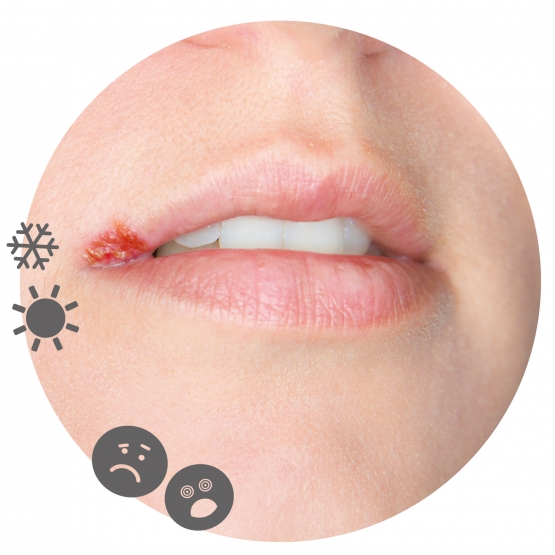
OTHER CONDITIONS CONTRIBUTE TO THE REACTIVATION OF THE VIRUS AND THE APPEARANCE OF COLD SORES
- Prolonged stress causes an increase in hormones such as norepinephrine and corticosterone. The excess presence of these molecules inhibits the action of T lymphocytes.
- Exposure to sunlight, particularly UV-B radiation, irritates the skin and causes erythema, resulting in the release of histamine and mediators of inflammation, including prostaglandins, which seem to play a significant role in the reactivation of the virus. The use of substances that protect the skin from solar radiation reduces recurrences. Keeping the skin hydrated and protected from direct sunlight is essential to promote wound healing, given the sun's dehydrating effect on open wounds.
- Hormonal changes that women are subjected to, such as during the menstrual cycle.
- Intense cold causes vasoconstriction and reduces the supply of oxygen and nutrients to tissues, making them more vulnerable to attack. Fine dust and pollution settle on the skin, irritating it and altering the lipid film, causing dehydration. Dehydrated skin is more prone to breakage and cracking, and the presence of lesions results in the release of inflammatory mediators which promote the reactivation of HSV-1.
- Arginine-rich foods such as walnuts, cashews, and chocolate provide large amounts of this amino acid. The virus capsid consists of arginine-rich proteins, so this amino acid is essential for virus replication.
ANTIVIRAL ACTION
GSE (GRAPEFRUIT SEED EXTRACT)
Studies conducted by Dr. Shannon have shown that GSE can inactivate HSV-1 after ten minutes of exposure at a dilution of 1:256. Furthermore, due to its selective antimicrobial properties, GSE can eliminate pathogenic microorganisms without significantly affecting the beneficial microbial flora. This facilitates the immune system's purpose, which, being less busy, can direct resources into maintaining the latent state of HSV. In vitro analyses have led to the hypothesis that the antiviral action against HSV is attributable to some of the flavonoids present in the phytocomplex such as naringin, naringenin, and quercitin.
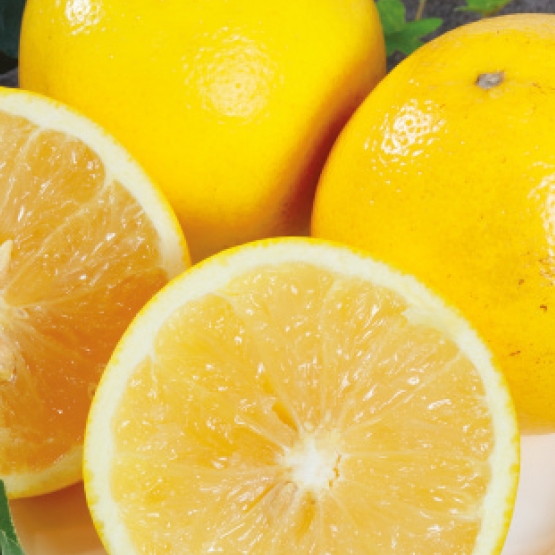
MELISSA OFFICINALIS
Lemon balm extract applied 2 to 4 times daily, locally as a cream, proved effective against HSV-1 and HSV-2. Treated subjects reported less extension of the lesion and alleviation of typical symptoms (burning, tingling, stinging, swelling, tightness, erythema), particularly on the second day of treatment, when discomfort is most pronounced, compared to the control group. Application of the extract from the appearance of the first symptoms gives excellent results and is also useful for the prevention of recurrence. Studies conducted in vitro have led to the hypothesis that the active ingredients in Lemon Balm extracts, including rosmarinic acid, caffeic acid, and p-cumaric acid, are able to inhibit HSV adhesion and entry into cells.
GLYCYRRHETINIC ACID (FROM LICORICE ROOT)
Glycyrrhizinic acid is a compound obtained through hydrolysis of glycyrrhizic acid, the main constituent of Licorice (Glycyrrhiza glabra). In vitro studies have demonstrated the efficacy of glycyrrhizic acid in inhibiting several types of viruses, including HSV, probably through interaction with certain protein structures essential for allowing the virus to infect cells. Subsequent studies have shown that glycyrrhetinic acid is ten times more effective against HSV-1 than its precursor. The antiviral action of glycyrrhetinic acid is associated with anti-inflammatory, antioxidant, and cicatrizing properties, as well as protection against damage induced by solar radiation.
VITAMIN C
Vitamin C is very helpful for viral infections, both for internal and external use. In a double-blind study, the application of a solution containing Vitamin C, repeated 3 times a day for several minutes, resulted in a reduction of the viral load in lesions, less permanence of scabs, and improvement of symptoms. The action mechanism, hypothesized through in vitro studies, seems to be related to the formation of hydroxyl radicals by Vitamin C and the action these exert on infected cells, accelerating their death and thereby limiting virus proliferation.
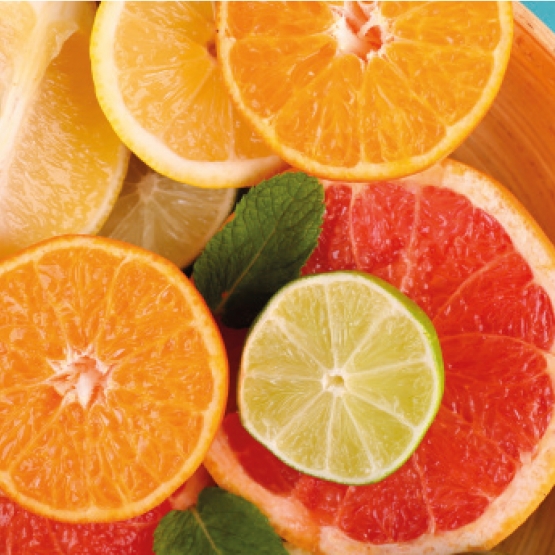
AMINO ACID SUPPLEMENTATION TO REDUCE VIRAL REPLICATION
L-LYSINE
L-lysine competes with arginine for intestinal absorption, intracellular transport, and reabsorption of arginine through the renal tubules. In addition, L-lysine stimulates the secretion of the arginase enzyme, which is responsible for the breakdown of arginine itself. In a clinical trial conducted in 45 patients, lysine treatment, at dosages ranging from 500 mg to 1,000 mg per day, was effective in shortening the healing time of acute phase lesions and reducing the frequency of recurrences. In a subsequent study, the amount of L-lysine given to subjects was increased to 3000 mg daily for 6 months: a lower incidence of recurrence, a marked reduction in symptoms and healing time, and the absence of side effects were observed.
Griffith R.S. et al., «A Multicentered Study of Lysine Therapy in Herpes simplex Infection». Dermatologica. 1978; (156) p.257-67.
Griffith R.S. et al., «Success of L-Lysine Therapy in Frequently Recurrent Herpes simplex Infection[LDL1] ».Dermatologica. 1987; (175) p.183–190.
IMMUNE SYSTEM SUPPORT AND NUTRITIONAL SUPPORT FOR THE BODY TO BETTER COPE WITH ENVIRONMENTAL FACTORS (INTENSE SOLAR RADIATION, COLD WEATHER), STRESS AND FATIGUE
UNCARIA TOMENTOSA
The traditional use of Uncaria tomentosa bark to treat viral infections has been substantiated by several studies. Bark extracts contained mainly polyphenols, quinovic acid glycosides, pentacyclic and tetracyclic oxindole alkaloids. These actives support the proper functioning of the immune system and have an anti-inflammatory effect, properties that are essential in HSV-1 infection. The actives present in Uncaria tomentosa have, in addition, antiviral effects against HSV-1 demonstrated in vitro: the molecules, acting in synergy with one other, appear to reduce the adhesion of the virus to cells and, in parallel, have a protective action against DNA damage induced by UV radiation.
Heitzman M.E. et al., «Ethnobotany, Phytochemistry and Pharmacology of Uncaria (Rubiaceae)». Phytochemistry. 2005; (66) p.5-29.
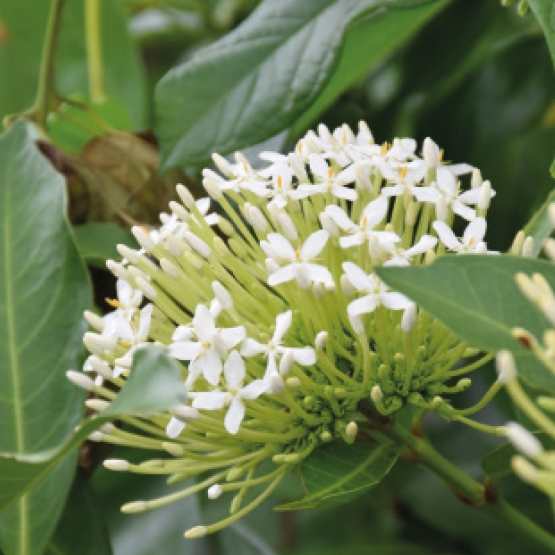
DULSE SEAWEED (PALMARIA PALMATA)
Red seaweed is widely used for nutritional and dietary purposes due to its high protein content, accounting for up to 35 per cent of its dry mass weight. Prominent among the amino acids present is L-lysine. Dulse Seaweed is also known for the presence of Vitamins C and B, useful molecules given their involvement in the repair of skin lesions, proper functioning of the immune and nervous systems. The use of Alga dulse powder, together with proper nutrition, helps the body adapt more easily to changes in external environmental conditions (cold, sun) and tiring situations (menstrual cycle, periods of stress).
Pereira L., « A Review of the Nutrient Composition of Selected Edible Seaweeds». Seaweed. Nova Science Publishers 2011.Chapter 2. p. 15-47
AN EMOLLIENT AND PROTECTIVE ACTION TO DECONGEST INFLAMMATION AND PROMOTE RESTORATION OF ALTERED TISSUES
PHYTOSQUALAN
Phytosqualane, a triterpene substance, is obtained through sophisticated extraction technologies from the unsaponifiable fraction of olive oil. Due to its structure, which is similar to some components of the skin's hydrolipid film, this molecule has a great affinity with the skin and contributes to the reconstruction of injured tissues. In fact, phytosqualane can penetrate even the deepest layers of the skin, having an emollient, restructuring and protective effect. Thanks to these properties, it helps to reform the hydrolipidic film, which has been altered by the presence of the herpetic lesion, and to restore the correct degree of skin hydration, leading to a more rapid resolution of the problem.
SUPPORT FOR SKIN REPAIR SYSTEMS
PHORPHYRA UMBILICALIS
The alga Phorphyra umbilicalis, growing in environments highly exposed to sunlight, has developed very effective photoprotection systems. This seaweed is rich in secondary metabolites (called MAAs, i.e., Mycosporine-like amino acids) characterized by extraordinary filtering abilities, particularly toward UV-A radiation, i.e., that portion of sunlight, at longer wavelengths, that is present consistently throughout the year, and that reaching deeper into the dermis, damages skin repair systems, causes collagen degradation and DNA damage, and induces the release of inflammatory mediators. In the case of herpetic manifestations, protection against UV-A is important for supporting the wound healing processes.
HERPES - LIFESTYLE - NUTRITION
LIFESTYLE – NUTRITION HERPES
A varied and balanced diet is the foundation for a healthy life. Knowing this means it can also be a valuable ally for specific afflictions such as cold sores. The first step is to avoid the abuse of foods that weaken the immune system: sugars, overconsumption of processed foods, fried foods, milk and dairy products, and red and processed meats (cured meats, sausages). Behavioral habits that are too often ignored should also be examined, such as cigarette smoking and mental and physical stress. The second step is to prefer foods that naturally have a higher concentration of lysine than arginine (primary structural units of proteins). Lysine, an antagonist of arginine, counteracts the replication of the herpes virus, whereas arginine has the opposite effect, favoring its replication.
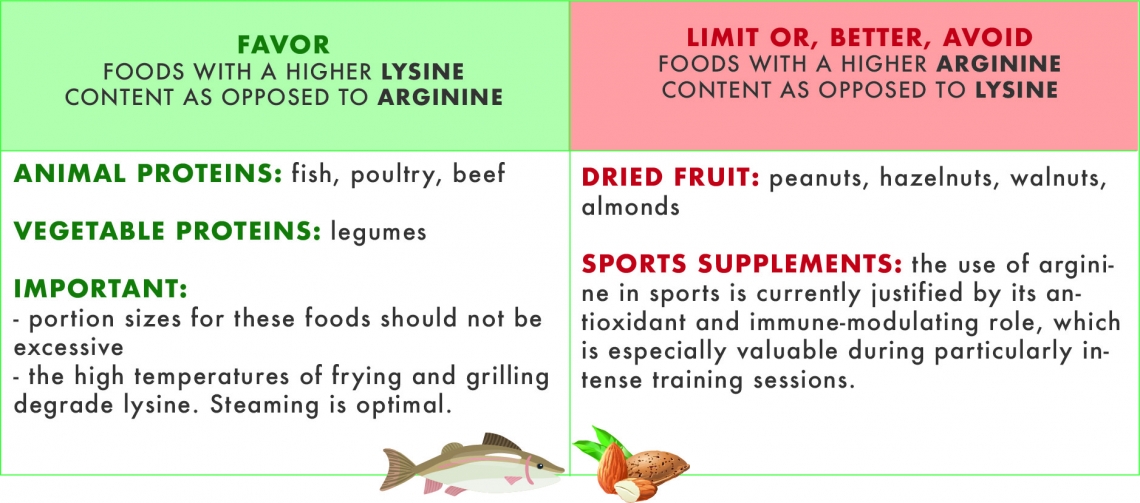
In addition, fruits, vegetables and grains should not be lacking in your diet: these are valuable sources of vitamins, minerals, antioxidants and fiber. Fiber is critically important for maintaining a healthy intestinal flora, a faithful ally of the immune system.
THE ADVANTAGES OF
- PARSLEY. Vitamin C is known to be a valuable ally of the immune system. It is present in considerable amounts in citrus fruits, but also in raspberries, blackberries, strawberries, blackcurrants, blueberries, cherries, kiwis, peppers, kale and many other fruits and vegetables. However, few people know about the large concentration present in parsley. Thus, a good alternative to the classic citrus juice is the parsley smoothie, prepared with ½ cup of parsley, 1 cup of diced pineapple or 1 kiwi, and 1 glass of water. The preparation method is simple: blend the ingredients and, if necessary, add additional water to obtain the desired consistency.
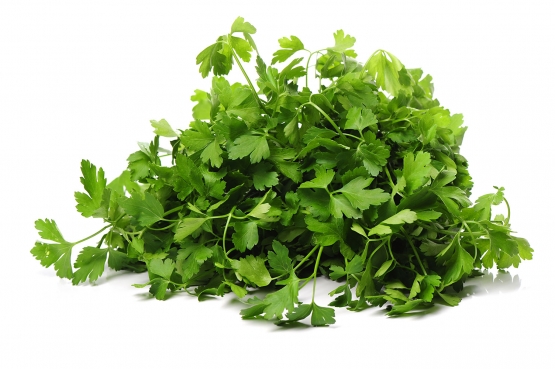
- GARLIC. Consumed raw, it has a powerful antibiotic and antiviral effect. It can be consumed as a sauce, which can be combined with many dishes, especially fish and meat, but also bread and vegetables. Agliata is a very simple sauce typical of Italian cuisine, used as a condiment for meat, fish, and vegetables. The existence of this recipe is documented as far back as the ancient Romans, but over the centuries, it has become especially popular in the Ligurian culinary tradition. It is prepared with crushed garlic, extra virgin olive oil, breadcrumbs, vinegar, salt and pepper, all well blended and evenly mixed. Toum is a sauce originating in Lebanon whose ingredients are fresh garlic, lemon juice and oil. These ingredients are traditionally pounded by hand in a wooden mortar; alternatively, you can use a blender or mixer until it has become a smooth white paste, similar to mayonnaise.
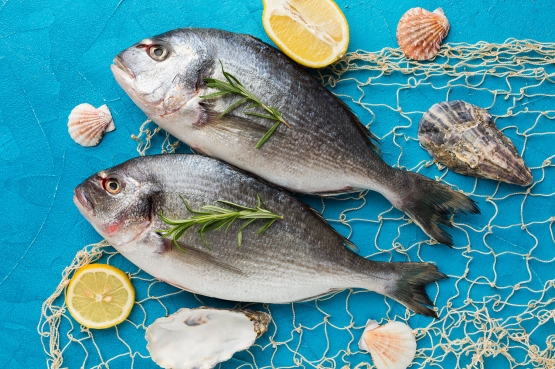
- FISH. A number of studies have shown that Omega 3 fatty acids have the extraordinary ability to modulate both immune response and inflammation. These are mainly found in blue fish and vegetable oils (flax and hemp oil). To preserve their valuable properties, the advice is to cook the fish in foil, otherwise high temperatures such as those during grilling will break them down. Zinc is another element useful for the development and functioning of the immune system, likewise found in fish, especially octopus, cuttlefish, seafood, etc.
IMPORTANT: In the acute phase, it is also important to limit the consumption of foods rich in histamine and/or histamine-producing agents, as they could amplify the inflammatory condition. Some examples are: aged cheeses, sour cream, strawberries, tomatoes, yeast, nuts, fermented foods, shellfish and crustaceans, smoked fish, processed meats (sausages, salami, jerky), etc.
- consuming foods of organic and/or 0-km origin
- in accordance with the above advice, following a varied diet, favoring the consumption of fruits and vegetables, preferably in season, easily digestible proteins (small fresh fish, white meat, eggs), legumes, pumpkin seeds, sunflower, flax, chia, etc., walnuts, almonds, hazelnuts, etc.
- consuming cereals, preferably whole grain but not only, because in some cases fiber prevents the absorption of minerals and other nutrients, semi-wholegrain cereals and pseudocereals (quinoa, buckwheat, amaranth)
- preferring foods that are sources of omega-3 fatty acids, such as flax oil, hemp oil, oily fish (mackerel, sardines, sardines etc.), chia seeds, flax seeds, etc.
- istaying adequately hydrated. Water requirements vary from individual to individual and change according to different lifestyles, type of activity and diet. An adult should generally drink 2 liters of water per day to maintain good health. Water is an essential element for the body because it regulates various biological functions. Therefore, it is important to maintain proper hydration, especially during the summer season, during sports activities and in all situations in which a lot of fluids are lost.
- avoiding abuse of gluten-containing foods, packaged foods and fried foods
- limiting sugar, sugary drinks, refined grains (white bread, white pasta, white rice, etc.)
- avoiding hydrogenated fats, limiting red meat, milk and its derivatives, and salt. When consuming them, prefer those of high quality
We inform you that the notions and advice offered herein are for educational purposes only and cannot under any circumstances replace medical advice. For a complete diet, it is necessary to consult a nutritionist, who, after appropriate clinical and instrumental examination, will be able to identify the needs of the person concerned and put together a personalized diet plan.